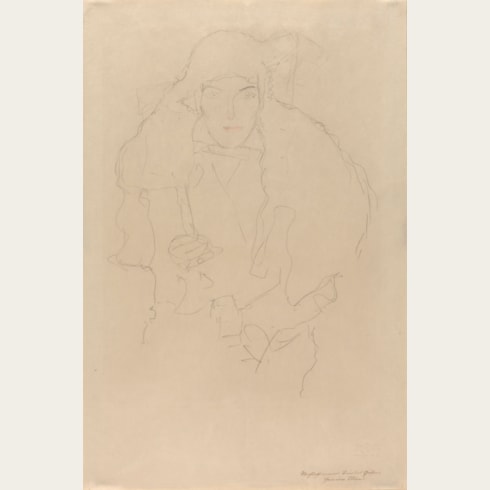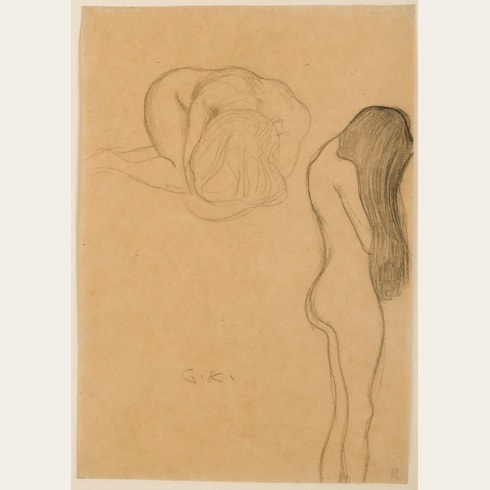Gustav KLIMT
(Vienna 1862 - Vienna 1918)
Study of a Female Nude, Seen from Behind
Sold
Pencil on cream wove paper.
Inscribed with a signature GUSTAV/ KLIMT near the lower left.
543 x 366 mm. (21 3/8 x 14 3/8 in.)
Inscribed with a signature GUSTAV/ KLIMT near the lower left.
543 x 366 mm. (21 3/8 x 14 3/8 in.)
This drawing may be a preliminary study for one of the six female nudes in Klimt’s large painting The Virgin (Die Jungfrau) of c.1913, today in the National Gallery in Prague. The painting, which measures around two metres square, was probably finished by the end of 1912 or the beginning of 1913, but was preceded by a large number of preparatory figure drawings dating from 1911-1912. The present sheet would appear to be an early study for the seated female nude seen from behind at the lower left of the painted composition.
As the Klimt scholar Marian Bisanz-Prakken has noted of the painting and its related drawings, ‘With the painting The Virgin, which he completed at the end of 1912 or at the latest by early 1913, Klimt took a crucial step in the area of his figural allegories. In this major work of his final creative phase, he grappled comprehensively for the first time with the various stages of erotic consciousness – from young girl to mature woman – which he saw as characterizing female existence…the numerous figure studies produced in 1911-12…feature a richly nuanced spectrum of emotional moods and erotic states of mind. In terms of appearance, the models vary from plain and stocky to highly sensitive, and their expression range from introverted shyness to effusive ecstasy. With regard to their typological diversity and the open eroticism of their poses, the figure drawings go far beyond the resulting painting. Each study is an autonomous step in the process of carefully analyzing this theme, one that would intensely occupy Klimt as a draftsman subsequently as well.’
The pose of the figure in this drawing is particularly close that of a pencil study of a seated nude, of similar dimensions and technique, in an Austrian private collection, in which, however, the arms of the figure are raised5.
As Bisanz-Prakken has noted of the artist’s drawn oeuvre, however, ‘numerous drawings are linked in a broader sense to the painted works rather than directly related to them’, and echoes of the nude in this drawing are also found in the left-hand figure in the large, unfinished painting The Bride (Die Braut) of 1917-1918, today in a private collection in Vienna, and in a few of the more than one hundred drawings which have been related to it.
This drawing was acquired by the celebrated Italian opera, theatre and cinema director Luchino Visconti (1906-1976) in 1966, when he was in Vienna to direct Giuseppe Verdi’s Falstafffor the Vienna Staatsoper, conducted by Leonard Bernstein.
As the Klimt scholar Marian Bisanz-Prakken has noted of the painting and its related drawings, ‘With the painting The Virgin, which he completed at the end of 1912 or at the latest by early 1913, Klimt took a crucial step in the area of his figural allegories. In this major work of his final creative phase, he grappled comprehensively for the first time with the various stages of erotic consciousness – from young girl to mature woman – which he saw as characterizing female existence…the numerous figure studies produced in 1911-12…feature a richly nuanced spectrum of emotional moods and erotic states of mind. In terms of appearance, the models vary from plain and stocky to highly sensitive, and their expression range from introverted shyness to effusive ecstasy. With regard to their typological diversity and the open eroticism of their poses, the figure drawings go far beyond the resulting painting. Each study is an autonomous step in the process of carefully analyzing this theme, one that would intensely occupy Klimt as a draftsman subsequently as well.’
The pose of the figure in this drawing is particularly close that of a pencil study of a seated nude, of similar dimensions and technique, in an Austrian private collection, in which, however, the arms of the figure are raised5.
As Bisanz-Prakken has noted of the artist’s drawn oeuvre, however, ‘numerous drawings are linked in a broader sense to the painted works rather than directly related to them’, and echoes of the nude in this drawing are also found in the left-hand figure in the large, unfinished painting The Bride (Die Braut) of 1917-1918, today in a private collection in Vienna, and in a few of the more than one hundred drawings which have been related to it.
This drawing was acquired by the celebrated Italian opera, theatre and cinema director Luchino Visconti (1906-1976) in 1966, when he was in Vienna to direct Giuseppe Verdi’s Falstafffor the Vienna Staatsoper, conducted by Leonard Bernstein.
Gustav Klimt was one of the foremost draughtsmen of the early 20th century. Over four thousand drawings by him are known today, the vast majority of which are drawn in black chalk or pencil, and occasionally in coloured pencils, as well as, more rarely, pen and ink. Many more drawings have been lost, however; the artist is known to have often thrown away his drawings, while some fifty sketchbooks were destroyed in a fire in 1945. Klimt regarded his drawings purely as working studies, and thus never sold them, although he would occasionally give some away. When a sheet left his studio in this way he would invariably sign it, but otherwise he rarely signed his drawings.
As has been noted, after about 1900 Klimt’s drawings ‘are almost exclusively of the human body, mostly rapid sketches in which he recorded a certain posture or detail of movement…The drawings were done very rapidly, and Klimt does not appear to have valued them once they had fulfilled their purpose.’ That Klimt did not regard his drawings too highly is seen in an anecdote recounted by the artist’s friend, the Austrian art critic Arthur Rössler: ‘Klimt valued this abundant evidence of his industrious and penetrating study of nature only as means to an end, and he destroyed thousands of leaves when they had fulfilled their purpose, or if they failed to combine maximum expressiveness with the application of a minimum of technique. On one occasion when I was sitting with Klimt, leafing through a heap of five hundred or so [drawings], surrounded by eight or nine cats meowing or purring, which chased each other around so the rustling leaves flew through the air, I asked him in astonishment why he let them carry on like that, spoiling hundreds of the best drawings. Klimt answered, “No matter if they crumple or tear a few of the leaves – they piss on the others and that’s the best fixative!”’
The Klimt scholar Marian Bisanz-Prakken has written of the artist that ‘His intensive study of the human – primarily the female – figure centred on the individual…Klimt drew obsessively, subjecting himself to a highly disciplined approach. He usually worked from life, whereby he would subordinate the models’ poses and gestures to an overarching design…As a creative draughtsman, Klimt was a law unto himself; as a result, the body of his works on paper is so rich and comprehensive that it must be viewed as a parallel universe, existing alongside his painterly oeuvre.’
As has been noted, after about 1900 Klimt’s drawings ‘are almost exclusively of the human body, mostly rapid sketches in which he recorded a certain posture or detail of movement…The drawings were done very rapidly, and Klimt does not appear to have valued them once they had fulfilled their purpose.’ That Klimt did not regard his drawings too highly is seen in an anecdote recounted by the artist’s friend, the Austrian art critic Arthur Rössler: ‘Klimt valued this abundant evidence of his industrious and penetrating study of nature only as means to an end, and he destroyed thousands of leaves when they had fulfilled their purpose, or if they failed to combine maximum expressiveness with the application of a minimum of technique. On one occasion when I was sitting with Klimt, leafing through a heap of five hundred or so [drawings], surrounded by eight or nine cats meowing or purring, which chased each other around so the rustling leaves flew through the air, I asked him in astonishment why he let them carry on like that, spoiling hundreds of the best drawings. Klimt answered, “No matter if they crumple or tear a few of the leaves – they piss on the others and that’s the best fixative!”’
The Klimt scholar Marian Bisanz-Prakken has written of the artist that ‘His intensive study of the human – primarily the female – figure centred on the individual…Klimt drew obsessively, subjecting himself to a highly disciplined approach. He usually worked from life, whereby he would subordinate the models’ poses and gestures to an overarching design…As a creative draughtsman, Klimt was a law unto himself; as a result, the body of his works on paper is so rich and comprehensive that it must be viewed as a parallel universe, existing alongside his painterly oeuvre.’
Provenance
Acquired in Vienna in 1966 by Lucchino Visconti di Modrone, Rome, until 1976
Thence by descent to a private collection, Italy, until 2017.
Thence by descent to a private collection, Italy, until 2017.
Literature
To be included in Marian Bisanz-Prakken’s forthcoming supplement to Alice Strobl’s catalogue raisonné of Klimt’s drawings.







